Weapon Guidelines
Here are the guidelines and dimensions for acceptable boffer weapons. Note that we reserve the right to accept or reject weapons for safety and/or aesthetic reasons. If you have an alternate construction technique beyond the standard (see Chapter 10: Resources), you must allow us to examine and discuss it with you, before we will sign off on it.
Note: Max Hilt length on most weapons is ⅖ total length
| Skill | Weapons | Total Length (inches) | Notes |
| Close | Dagger | 12 – 20 | |
| Hatchet | 14 – 22 | Head: 4 – 8” length | |
| Sap | 12 – 18 | Subdue with regular strike | |
| Sword | Short Sword | 21 – 33 | |
| Long Sword | 34 – 46 | ||
| Great Sword | 48 – 62 | Heavy | |
| Giant Sword | 72 – 84 | Giant, Blade width no narrower than 2.5”,
save at thrusting tip. |
|
| Axe | Short Axe | 21 – 35 | Head: 6 – 12” length |
| Battle Axe | 36 – 48 | Head: 9 – 18” length | |
| Great Axe | 50 – 64 | Head: 12 – 18” length | |
| Monster Axe | 74 – 86 | Giant. Striking surfaces MUST be
composed of open cell foam. NO EXCEPTIONS |
|
| Polearm | Staff | 60 – 72 | Center grip no more than ⅖ total length |
| Spear | 48 – 62 | Head: 8 – 12” length | |
| Halberd | 60 – 72 | Head: 18 – 24” length | |
| Great Staff | 84 – 96 | Giant. May be fully used one handed if
Strong 4. Center grip no more than ⅖ total length |
|
| Mace | Short Club/Hammer/ Mace | 21 – 33 | |
| War C/H/M | 36 – 48 | ||
| Great* C/H/M | 48 – 62 | Heavy | |
| Giant Cudgel | 72 – 84 | Giant. Must have spikes/striking surfaces
every 4” down most of its length |
|
| Titan Hammer | 72 – 84 | Giant. Striking surfaces MUST be
composed of open cell foam. NO EXCEPTIONS. |
|
| Dire Mace | 72 – 84 | Giant. Striking surfaces must be
composed of open cell foam. NO EXCEPTIONS |
|
| Missile | Bow | 30 lb max pull | Arrow length: 34” max |
| Crossbow | 25 lb max pull | Bolt length: 34” max | |
| Thrown Weapon | 6 – 12” | Must be 100% foam | |
| Slingshot | — | Medical tubing/bands, 100% foam ammo
Which must be 1.5 – 4” across |
|
| Railcaster | Up to 18” length | Model magic foam or closed cell ammo.
Spring loaded, single shot. |
Axe Weapon Notes (Including Hatchet)
Blades must be made of foam that is 1 – 3 inches thick .
Mace Weapon Notes
Clubs must have open cell foam knobs/spikes every 4 inches down most of their shaft length, or taper to a double-width end. Mace heads must be a minimum of 6/8/10” length (down shaft), with multiple flanges, spikes, or a ball end. Hammer heads must be at least as wide (perpendicular to shaft) as they are long, and must be at least 2/3/4” thick, respectively, with the same length heads as maces of the same type.
Giant Weapon Notes
Giant Cudgels must have open cell foam knobs/spikes every 4 inches down most of their shaft length, or taper to a double-width end. Dire Mace heads must have a 18-24” length (down shaft), with multiple flanges, spikes, or a ball end.Titan Hammer heads must be at least as wide (perpendicular to shaft) as they are long, and must be at least 5” thick, respectively, with 12-18” length heads. Monster Axe heads must measure 18 – 24” length and must be constructed of foam that is from 1 1/2-4” thick, though they may be beveled to 1/2.” Monster Axe heads must be at least as wide relative to their shaft as they are long.
Unarmed Notes
Some Advanced Fighting Styles require Unarmed phys reps to meet the style requirements. Unarmed Phys Reps follow the short sword guidelines and are constructed in the same method as a staff:
- Total Length: 21-33 inches
- 2 inch open cell foam tip at each end
- Center Grip no more 1/4 the total length
- Red tape to note “Natural Weapons”
Railcaster Notes
Railcasters are phys-repped by four requirements:
- spring-powered
- muzzle-loaded
- single-shot
- pistol-sized
Railcasters fire ball projectiles made from model magic or closed-cell foam. Note that these weapons have strict phys-rep requirements, so players interested in making or purchasing them should contact staff for additional details.
Armor Guidelines
Armor tends to be the largest component in a character’s Resilience, ranging in value from 1 to 6 points, and it can be readily maintained. Armor is lost first when a character takes a damage effect, followed by magical Protection and then Vitality (resilience is lost in alphabetical order, essentially: A-P-V). Note, however, that there are no effects in game which bypass one protection form or another that do not simply ignore resilience altogether, so keeping track is only important when figuring out when to recast spells, get some rest, or maintain armor.
Armor Maintenance requires at least Basic Repair (Craft 1), which allows a character to refit any suit of armor back up to its maximum value, even if it is at 0. This process takes 10, 5, or 1 minute of roleplaying the repair, depending on the ability used, but the character need not remove the armor in order to do so. See Chapter 5: General Skills, for further details.
Armor Styles
There are three basic styles of armor: leather, chain, and plate. Each style provides varying amounts of protection dependant on the amount of coverage it gives to vital locations. Please note that the armor ratings are an abstraction created for game balance and not for historical or physical accuracy. Aesthetics are a very important factor in allowing armor in game, and we reserve the right to reject a suit if we believe it is inappropriate.
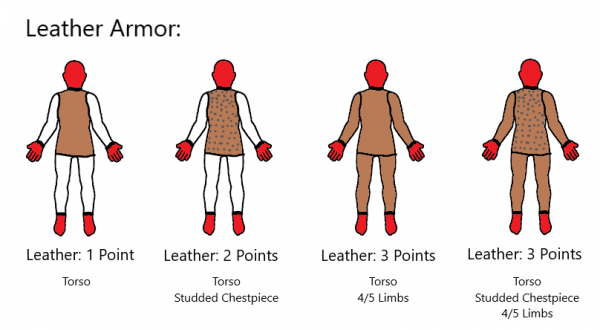
Leather Armor provides one point of armor if it covers the torso, and it provides another point if it protects at least four of your five limbs (head, arms, and legs). If more than 50% of the leather on the torso is studded then you receive an additional point of armor.
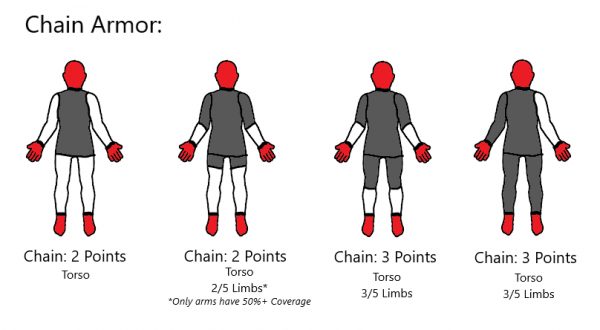
Chain Armor provides two points of armor if it covers the torso; it provides another point if it protects at least three of your five limbs (head, arms, and legs).
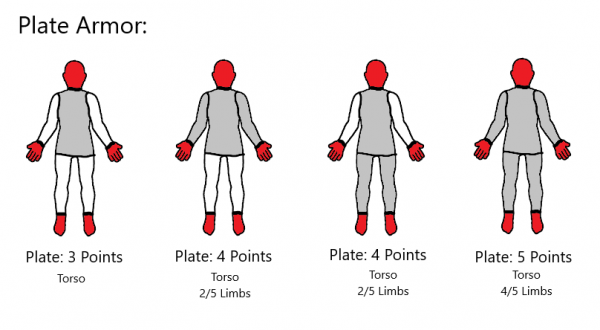
Plate Armor provides three points of armor if it covers the torso; it provides another point if it protects at least two of your five limbs, and two points if it covers four of your five limbs.
Any combination of armor which totals 4 or 5 points is considered to be “Heavy” armor. There are no trait requirements and players may wear any type of armor.
There are myriad different types of armor throughout history and in fantasy beyond basic leather, chain and plate, but we filter these styles into these three groups whenever possible. Below is a sampling of these types and which class they fall into our groupings.
Note that this list is by no means exhaustive:
Leather: Padded Cloth, Chain “Bikini”
Leather w/ studs: Thick Hide, Bamboo, Ring Mail
Chain: Brigandine, Scale Mail, Plate Mail “Bikini”
Plate: Lamellar, Banded, Splinted
Coverage
For armor to give its full benefit, it must cover more than half of the torso or limb that it is to be protecting. If the armor covers less than half the area that it is protecting and more than one third then it is treated as if it was armor of a class one level lower than it. For example a Plate bracer that reaches from the wrist to the elbow would count as fully protecting that arm as plate armor. If it only reached from the wrist to just over halfway up the forearm, then it would count as chain. Steel bracelets that cover only the wrists would not count as armor at all.
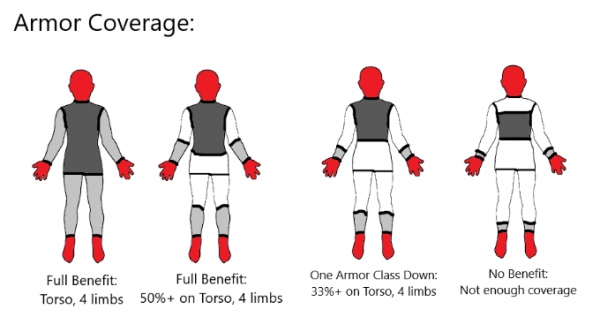
Helmets
A helmet must fit on the head and not fall off when the player bends over ninety degrees at the waist, for obvious safety reasons. Helmets must be made of reasonably rigid material and hats do not qualify. A helmet counts as 1 point of armor if it meets the plate or chainmail construction requirements, otherwise it only counts as a limb as normal.
Piecemeal Armor
When determining the value of piecemeal armor (armor composed of various types) you count the piece that gives the highest value only. So if you are wearing full leather sleeves and plate bracers that reach from the wrist to the elbow, you would count them as plate armor; they provide the greatest protection even though the leather is providing the greater coverage.
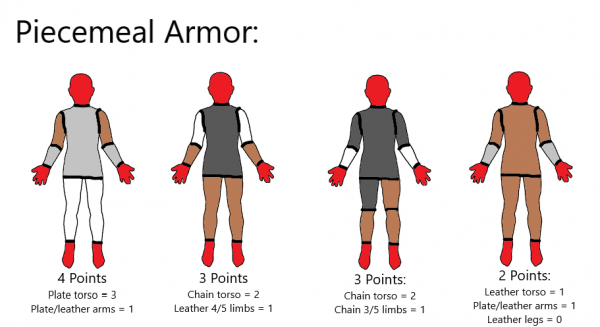
Item Tags
Armor is given in-game tags as full suits, not as separate pieces. This means that if a suit of armor’s total value is between 1 and 3 it counts as light armor for the purposes of crafting. If a suit’s full armor value equals 4 or 5 then it counts as heavy armor for the purpose of crafting.
Materials Substitutes
Leather: characters can use synthetic leather, but it must be appropriately thick.
Chain: chain mail may be made of metal of any type.
Plate: plate armor may be made of metal, or of thick, rigid plastic made to look like metal. This can include thermoplastics such as Worbla or Sintra, 3D printed pieces out of ABS, PLA, or PETG.
Shield Types and Guides
Buckler: Maximum area of 216 square inches (equal to a circle 16 inches in diameter) with no dimension greater than 21 inches. Minimum area of 50 square inches (equal to a circle 8 inches in diameter) with no dimension greater than 11 inches. Bucklers may be attached to the arm with straps, leaving the shield hand free, or used with a handle.
Small Shield: Maximum area of 454 square inches (equal to a circular shield 24 inches in diameter) with no dimension greater than 30 inches. Small shields must have a handle, and arm straps are optional.
Large Shield: Maximum area of 531 square inches (equal to a circular Shield 26 inches in diameter) with no dimension greater than 36 inches. Large shields must have a handle, and arm straps are optional.
Note : All shields must be constructed from a solid base of wood, metal, or other robust material; foam shields are not allowed. All shields must also have at least 5/8″ closed cell foam edging, and they may have no bolts, screws, or nails sticking out from their face.
